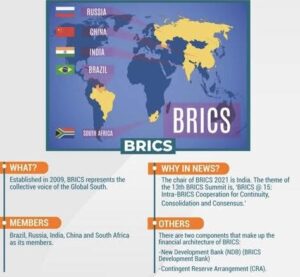Scenarios for the future of India, and the world
Mains GS Paper II & III: Significance of G20 countries, Bilateral, regional and global grouping and agreements involving India or affecting India’s interests.
ARTICLE SUMMARY
- The fast growth of BRICS (Brazil, Russia, India, China, South Africa) economies was forecast by economists at the turn of the millennium.
- The prediction had a large impact on the public imagination and on corporate investments.
Context
BRICS:
Background of rise of BRICS:
- Japan: The post-war performance of Japan, had predicted that the 21st century would be Japan’s century.
- Some Economists: Predicted the quick collapse of the Soviet Union or foresaw China’s remarkable ascent.
- In the next decade: Japan’s growth was limping, the Soviet Union was history, and China was the country investors were being directed to.
- India, Brazil, Russia, and South Africa were the other four Economic powerhouses.
WEF’s scenario planning exercise for the BRICs countries-2004(collaboration with the Confederation of Indian Industry (CII)):
- Systems thinking: The foundational discipline of scenario planning was systems thinking.
- Scenario planning does not begin with the data: It starts with listening to diverse points of view
- About what is going on within a complex system at present
- To understand the undercurrents that will surface and disrupt predictions of economists’ models.
- Scenarios depict shapes that a country’s economy may take in the future depending on changes in social and political conditions with economic growth.
- Systems’ scenarios include subjective perceptions of poverty and inequality.
- Includes Mistrust in institutions of governance: which are “externalities” to economists’ quantitative models.
WEF/CII report, ‘India and the World: Scenarios to 2025’ (published in 2005):
- BollyWorld: It revealed forces which would dampen growth in the future if not responded to in good time.
- Atakta Bharat: It showed how increasing inequality and insecurity could compel the government to impose controls on politics for security
- It also compels to play a larger role in the economy without adequate resources.
- Enterprises by the people for the people: The changes that people need are produced by them:
- By local leaders of women’s self-help groups
- Cooperatives for water conservation
- farming and dairying
- Profitable business enterprises based on local production and consumption.
- Pahale India: The scenarists projected that by this model, economic growth would be more inclusive, more environmentally sustainable, and faster too.
Positive impacts of opening of economy:
- More opportunities for private enterprises
- Wealth increase: Rapid increases in the wealth of the top 1%.
- Young people aspired to become wealthy.
Negative impact:
- Signs of their increasing frustration.
- Violence was not restricted to rural, “Naxal” areas
- Petty urban crimes, many violent, also increased.
Why these predictions about India?
- India Shining: India was in an “India Shining” mood at that time.
- Fastest growing economy: It was celebrated as “the world’s fastest growing free market democracy” to tempt western investors.
Way Forward
- Glamour and violence can be mixed for the entertainment of viewers of Bollywood movies.
- However, India’s “BollyWorld” economic growth is a real story that is becoming painful for millions of citizens living in it.
- Increasing inequality and insecurity around the world, rising along with “free market” globalization, have resulted in reactionary forces in many countries, including China and Russia amongst the BRICs.
- They have appeared in India too.
- Concentration of power in governments and large business monopolies for imposing more security and pushing faster GDP growth.
- This leads to further unrest and “ Atakta” (stalling)
- Local systems solutions for environmental and economic problems, cooperatively implemented by communities.
- This model solves global systemic problems
- It also creates a more harmonious world.
- India must promote this model in the G-20 it is hosting this year.
- Gandhian approach: India must also adopt this “Gandhian” approach more determinedly to make “ Pahale India” a reality for all Indian citizens.
- South-south cooperation: We need to expand south-south cooperation to share experiences on food and agriculture production and make expanded efforts to share India’s experiences for countries in Africa and Asia.
QUESTION FOR MAINS
- Is inclusive growth possible under market economy ? State the significance of financial inclusion in achieving economic growth in India.(UPSC 2022) (200 WORDS, 10 MARKS)




